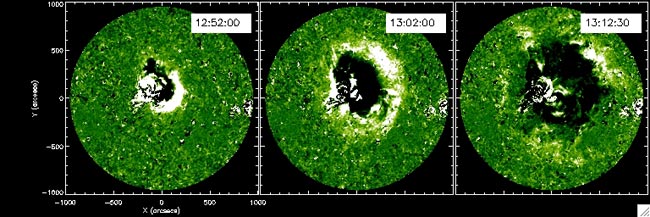Solar Tsunamis Move at Astronomical Speeds

Images of atsunami blasting its way through the sun's lower atmosphere have been taken forthe first time.
NASA's twinSTEREO spacecraft captured one of the massive solar waves in action May 19,2007, as it moved through four layers of the solar atmosphere. These images andvideos,released today, have helped astronomers to revise estimates of the waves'speeds.
Astronomersthink that solartsunamis, initially discovered by the SOHO spacecraft in the late 1990s,are something like the tsunamis in Earth's oceans. Like these monster oceanwaves, solar tsunamis are the result of a release of energy that creates apressure wave that propagates through some kind of medium. On Earth, thatmedium is ocean water, but on the sun, it is hot, roiling solar gases.
Tsunamisand CMEs
Early onand still today, there are many unknowns about solar tsunamis. The speed of thewaves as calculated based on the first SOHO snapshots didn't match up withtheir estimated intensity. "They seemed to be going very slowly for theamount of energy we saw in the explosion," said study leader PeterGallagher of Trinity College Dublin. The explosions release about two billiontimes the annual world's energy consumption in just a fraction of a second.
STEREO'scameras took more images per day than SOHO, so Gallagher and his colleagueswere able to more accurately clock the speed of the solar tsunamis at more than1 million kilometers per hour.
"They'reactually traveling a lot faster than we previously thought," Gallagher toldLiveScience. "The speeds are astronomical, literally. These things[take] blinks of an eye to traverse the Earth."
Get the Space.com Newsletter
Breaking space news, the latest updates on rocket launches, skywatching events and more!
STEREO'sExtreme Ultraviolet Imager (EUVI) instruments also allow astronomers to monitorthe sun at four wavelengths which correspond to temperatures from 60,000 to 2million degrees Celsius. Each wavelength corresponds to a different layer of the solaratmosphere. To the team's surprise, the tsunami seemed to move just asspeedily through dense layers as it did through less dense layers, Gallaghersaid.
Unclearcauses
What causesthese giant solar waves isn't clear. Astronomers know they are associated withcoronal mass ejections (CMEs) which are like "a rope of gas and magneticfields that gets accelerated away from the sun," Gallagher explained.
Solartsunamis could be the shockwave that results from the CME, or they could simplybe related phenomena that have a common trigger. But whenever they see a solartsunami, there's always an associated CME, Gallagher said. "When [a solartsunami] goes off, it tells you that there's been an explosion on thesun."
Thisrelationship could be important in predicting CMEs,which can launch damaging material at Earth and the other the planets.Gallagher thinks further STEREO observations will help astronomers decide whatcauses what.
Gallagherand his colleagues will present their findings on April 2 at the RoyalAstronomical Society National Astronomy Meeting in Belfast, Northern Ireland.
Join our Space Forums to keep talking space on the latest missions, night sky and more! And if you have a news tip, correction or comment, let us know at: community@space.com.

Andrea Thompson is an associate editor at Scientific American, where she covers sustainability, energy and the environment. Prior to that, she was a senior writer covering climate science at Climate Central and a reporter and editor at Live Science, where she primarily covered Earth science and the environment. She holds a graduate degree in science health and environmental reporting from New York University, as well as a bachelor of science and and masters of science in atmospheric chemistry from the Georgia Institute of Technology.









